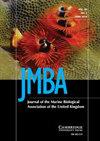A first genome survey sequencing of alvinocaridid shrimp Shinkaicaris leurokolos in deep-sea hydrothermal vent environment
IF 0.9
4区 生物学
Q3 MARINE & FRESHWATER BIOLOGY
Journal of the Marine Biological Association of the United Kingdom
Pub Date : 2023-09-06
DOI:10.1017/S0025315423000504
引用次数: 0
Abstract
Abstract The alvinocaridid shrimp Shinkaicaris leurokolos Kikuchi and Hashimoto, 2000, is an evolutionarily important deep-sea species in hydrothermal vents of north-western Pacific. A genome survey of S. leurokolos was carried out in order to provide a foundation for its whole-genome sequencing. A total of 599 Gb high-quality sequence data were obtained in the study, representing approximately 118× coverage of the S. leurokolos genome. According to the 17-mer distribution frequency, the estimated genome size was 5.08 Gb, and its heterozygosity ratio and percentage of repeated sequences were 2.85 and 87.03%, respectively, showing a complex genome. The final scaffold assembly accounted for a total size of 9.53 Gb (32,796,062 scaffolds, N50 = 597 bp). Repetitive elements nearly constituted 45% of the nuclear genome, among which the most ubiquitous were long interspersed nuclear elements, DNA transposons and long-terminal repeat elements. A total of 12,121,553 genomic simple sequence repeats were identified, with the most frequent repeat motif being di-nucleotide (70.27%), followed by tri-nucleotide and tetra-nucleotide. From the genome survey sequences, the mitochondrial genome of S. leurokolos was also constructed and 71 single nucleotide polymorphisms were identified by comparison with previous published reference. This is the first report of de novo whole-genome sequencing and assembly of S. leurokolos. These newly developed genomic data contribute to a better understanding of genomic characteristics of shrimps from deep-sea chemosynthetic ecosystems, and provides valuable resources for further molecular marker development.深海热液喷口环境中Alvinocarid虾Shinkaicaris leurokolos的首次基因组调查测序
摘要菊池新海虾和桥本虾,2000年,是西北太平洋热液喷口中进化上重要的深海物种。对勒氏乳杆菌进行了基因组调查,为其全基因组测序奠定了基础。该研究共获得599Gb的高质量序列数据,代表了S.leurokolos基因组的约118倍覆盖率。根据17mer的分布频率,估计的基因组大小为5.08Gb,其杂合率和重复序列百分比分别为2.85%和87.03%,显示出复杂的基因组。最终支架组件的总尺寸为9.53 Gb(32796062个支架,N50=597bp)。重复元件几乎占核基因组的45%,其中最常见的是长穿插核元件、DNA转座子和长末端重复元件。共鉴定出12121553个基因组简单序列重复,最常见的重复基序是二核苷酸(70.27%),其次是三核苷酸和四核苷酸。从基因组调查序列中,还构建了S.leurokolos的线粒体基因组,并通过与先前发表的参考文献的比较,鉴定了71个单核苷酸多态性。这是第一份关于S.leurokolos的从头全基因组测序和组装的报告。这些新开发的基因组数据有助于更好地了解深海化学合成生态系统中虾的基因组特征,并为进一步开发分子标记提供了宝贵的资源。
本文章由计算机程序翻译,如有差异,请以英文原文为准。
求助全文
约1分钟内获得全文
求助全文
来源期刊
CiteScore
2.30
自引率
8.30%
发文量
68
审稿时长
3-8 weeks
期刊介绍:
JMBA is an international journal, publishing original research on all aspects of marine biology. It includes pioneering work taking place today on major issues concerning marine organisms and their environment. Subjects covered include: ecological surveys and population studies of marine communities; physiology and experimental biology; taxonomy, morphology and life history of marine animals and plants; and chemical and physical oceanographic work. Included with 2010 online subscriptions: Marine Biodiversity Records.

 求助内容:
求助内容: 应助结果提醒方式:
应助结果提醒方式:


